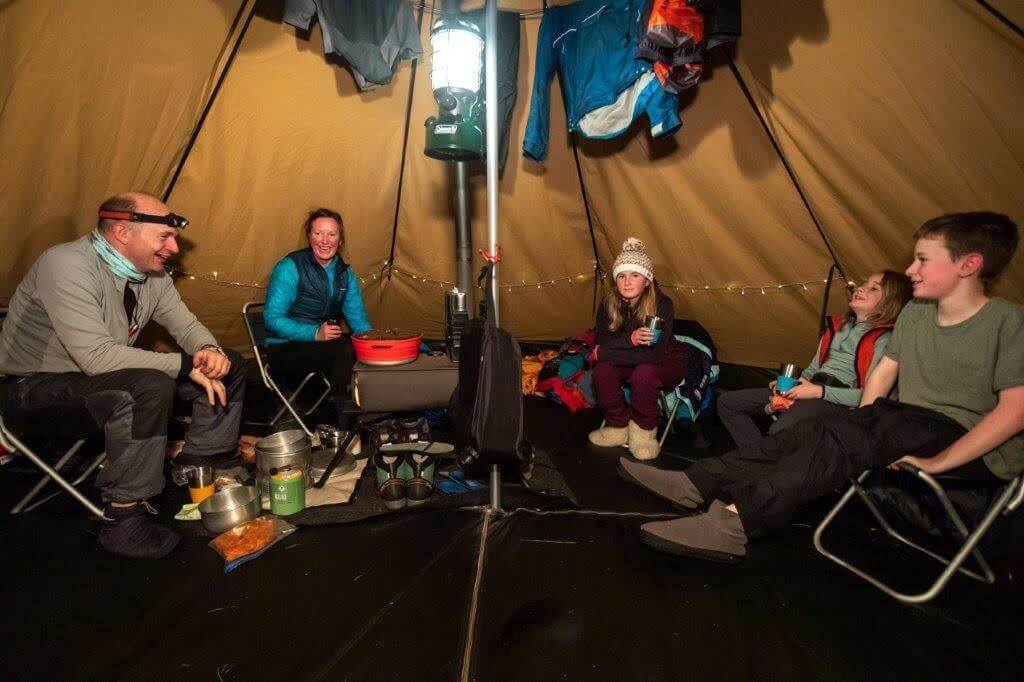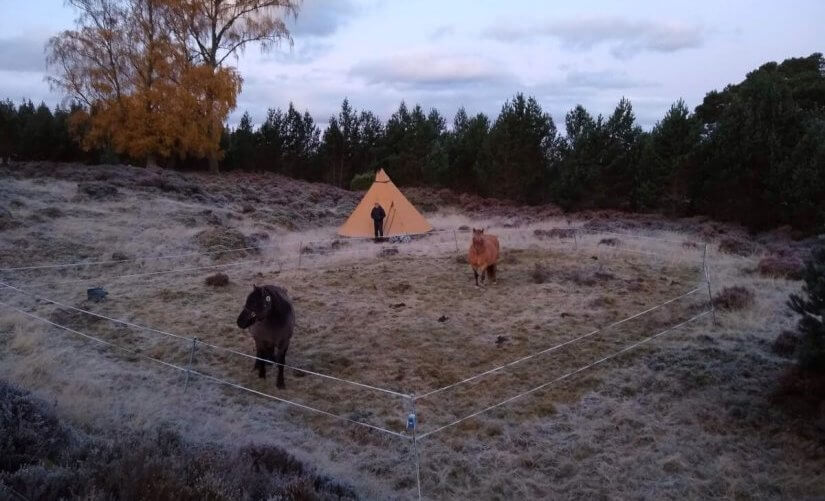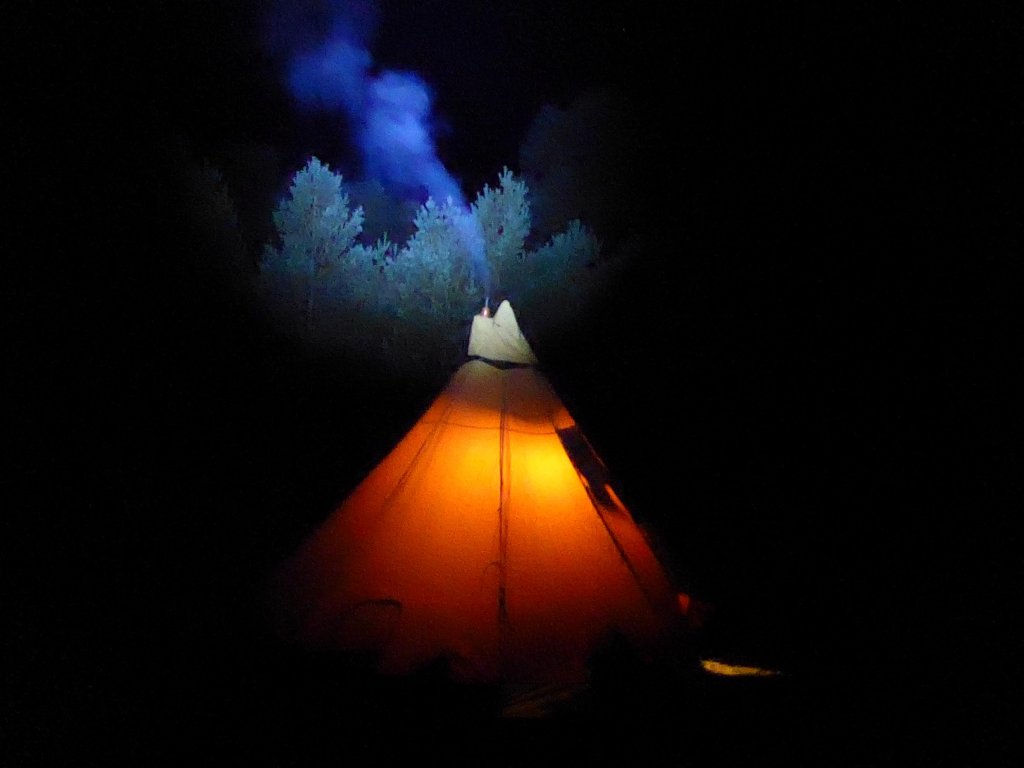In fine summer conditions wild camping, in the UK can be a glorious experience. As a youngster, a high wild camp in the mountains was one of the most wholesome, formative and enjoyable experiences of my life, and still is.
For a large chunk of the year though, a wild camp can often end up being an experience that’s endured rather than enjoyed. Along with the sun loosing its summer strength goes its ability to appreciably warm and reduce the humidity of our damp maritime air as it moves inland. By Day 2 of any multi-day trip, that pervasive damp has invariably got into your gear. Worse, if any of your gear gets wet at this time, the only realistic chance of drying it is to wear it!
Without any risk of exaggeration, adding a camp wood burner to your tent is a COMPLETE and UTTER GAME CHANGER! This isn’t something new. The indigenous people of the Arctic have been doing it since time beginning. What is new is the availability of camp wood burners in the UK.
With the stove we use, it’s quite possible, whist having an outside temperature close to freezing, to basking in 25 degrees of heat inside!
With a smaller tent and a larger stove, the Ray Mears boast of 28 degrees C inside whilst the outside temperature is minus 35 degrees becomes entirely believable! (start at 4:30 in if you’re pushed for time).
This elevated temperature has the effect of substantially reducing the relative humidity of the air and the prospect of being able to banish that damp.
Combining a camp wood burner with a tent or teepee made of a naturally breathable poly-cotton canvas creates a remarkably dry atmosphere. Even to the point that the upper surface of a ground sheet in contact with cold ground will readily dry!
A teepee style tent gives a wonderful drying area in its upper reaches, the apex. It is, of course, the warmest part especially with the flue pipe going straight up through the centre.
In the depths of winter, if you’re able to keep the stove in over night it is quite possible to have dry gear by the morning, and that includes boots! A wood burner raised adequately up off the ground allows boots to be placed under it without drying the leather out too aggressively.
For us the “après” adventure, the evening meal, etc has always been an important part of the whole experience. The central camp stove provides a wonderfully cosy focal point around which guests can sit, relax and enjoy each others company. Often the only adequate cosy alternative when using conventional camping gear is to cocoon yourself in your sleeping bag.

Deadwood is a very important part of any woodland ecosystem, especially so in nature conservation areas, It’s the food of fungi, larvae, etc that then in turn feed other wildlife species. This should be born in mind when sourcing wood and if necessary fuel should be taken with you. It is also worth bearing in mind that deadwood is the legal property of the landowner.
Depending on the time of year it may be difficult to find dry wood in the wild. As is the case with burning any damp or “green” wood, a lot of heat energy is lost in the form of latent heat evaporating the water rather than it raising the temperature.
Make sure you take extra care to dispose of any ashes and cinders safely. You need to be super careful when wild camping to avoid any risk of starting a wild fire.
If you’d like to try hot tent camping, before investing in all the gear yourself you might want to consider this trip: Hot tent camping with Scot Mountain Holidays
We’re bringing out another trip soon based on the isle of Rum in early April and hot tent camping for the duration. Keep an eye on the website for details.
It’s not easy to know what to pack for a new type of vacation, especially if you’ve got a longer holiday planned. You want to make the most of your trip though so always a good idea to have a check list of things you really don’t want to forget. It’s also nice to know what you don’t need to pack, if some of the gear is being provided for you then that takes the pressure off your bags.
We’ve put together the ideal kit list of the wilderness glamping trips just so there isn’t anything vital that you forget to bring because it’s not like you can stock up while you’re out on the adventure: there aren’t any stores around.
You might be surprised to find that you there’s little or nothing you need to buy to come on this trip. Hint: All the camping/glamping gear is provided by Scot Mountain Holidays.
featuring our newest innovative adventure – Highland Wilderness Glamping
Have you ever been trekking in Peru? Hiking in the Himalaya? Walking in France?
What about wild camping?
We have been hut-to-hut trekking and we have been wild camping. The joy of hut-to-hutting, especially in many parts of Europe, is that you really don’t have to carry much gear, but you get to stay in some of the most amazing situations; in huts high in the wild mountains. In Scotland, you can really only enjoy such a wild experience, well away from the road or camping high in the hills, if you carry all your gear with you. And if you’re also taking the family this means that at least one of you ends up carrying a truly heavy pack. You’ll have all your gear and half the kids’ gear as well along with a tiny tent and cooking gear.

Family Adventure Holidays in the Cairngorms
Having experienced both extremes, we’re happy to say that we hit on a solution to bring light weight/small pack camping to Scotland. The solution was right under our noses: camping + ponies! Why not? In many countries abroad mules and donkeys are used to carry camp equipment high into the mountain ranges. Then hikers can access really remote trails comfortably.

Highland ponies have been bred to carry loads. They are traditionally used to carry deer down from the hill. Many Highland estates keep ponies for this reason. It is a skilled job for both ghillie (pony handler) and pony. There are therefore a lot of factors to be considered when working with animals
View this post on Instagram
We asked the local experts and Andy spent a lot of time learning how to look after ponies and gathering the best gear he could find. He also needed to find some quiet routes and a suitable off-the-beaten-track camp site big enough for the tentipi and with grazing for the ponies. It’s hugely complicated to put these trips together, but after years of preparation they’re on the market.
We’ve found a way to remove the deal breakers of wild camping. After all, not everyone wants to carry a heavy pack; not everyone wants to poo in the wild (nor do they know how to do it in a respectful and leave no trace way); not everyone wants to eat freeze dried rations; no one wants to be soaking wet. With the gear Andy has invested in and the ponies to accompany us, we’ve found a way to get rid of all these issues. Join Andy for an unforgettable outdoor adventure with all kinds of unexpected bonuses: foraging, pony friends, hot tenting, dry clothes, dry shoes, fresh air, and COVID safe.

How a Highland pony always beats a quad bike
You can also check out the videos on YouTube featuring Sylvia Ormiston who manages the Queen’s herd of Highland ponies at Balmoral.
All content © Copyright Scot Mountain Holidays 2024
Responsive web design by Summit Web Solutions